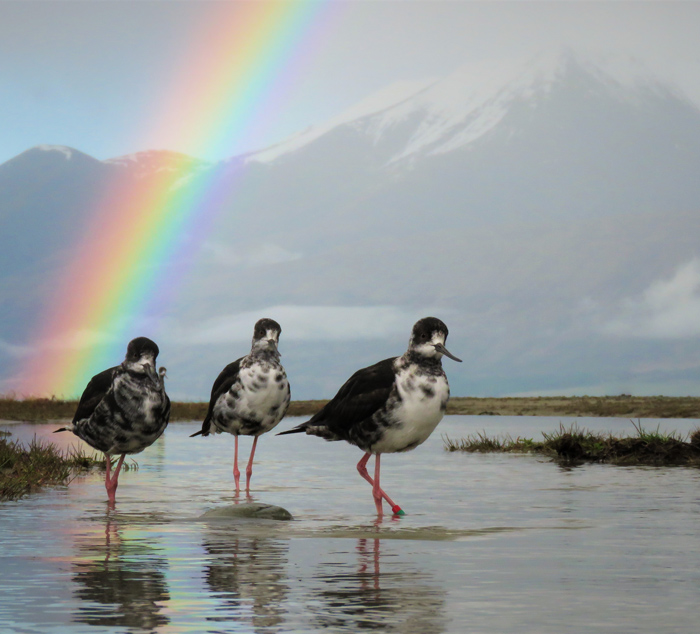
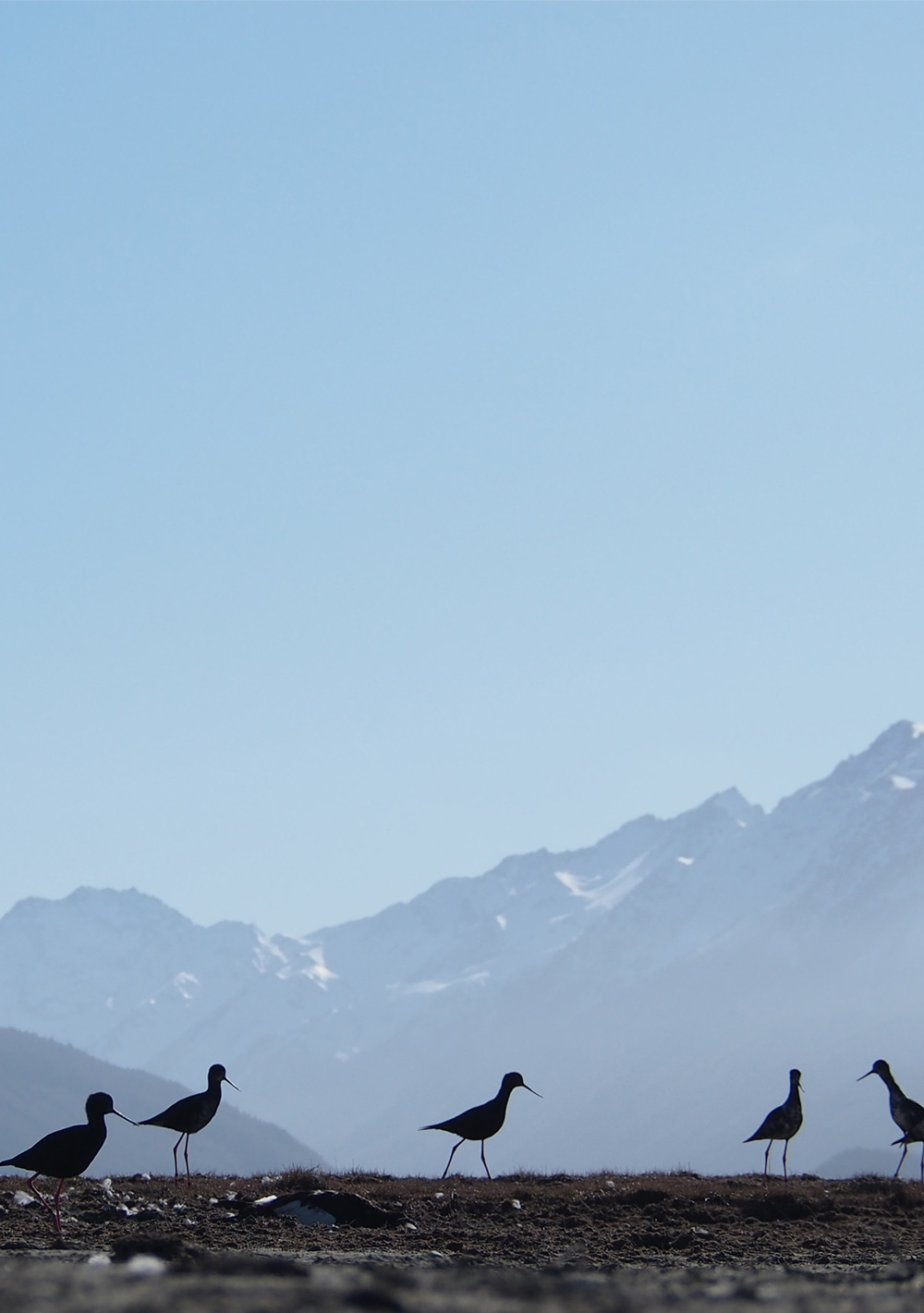
ONE EGG AT A TIME
BRINGING KAKĪ BACK FROM THE BRINK
Forty years ago the world’s rarest wading bird, the kakī/ black stilt, teetered on the brink of extinction with just 23 birds left. Its survival has depended on one of the most intensive and successful captive rearing programmes in the country. Will it be enough to save them?
By George Driver
It’s not often you get to be in a building where almost an entire species came into this world, but you can visit one near Twizel. In a couple of basic, corrugated iron-clad buildings, past a power substation and down a pot-holed, gravel road a few kilometres out of the town, is a place Liz Brown calls a “bird factory”. “It’s a production line,” she says.
For the last 14 years, Brown has run DOC’s kakī captive management centre. Every spring, a team finds every known breeding pair of kakī, takes every egg they lay and brings them to her.
In the lab-like hatchery — picture fridge-white walls, stainless-steel benches, fluorescent lights and a general air of sterility — every variable of the chicks’ environment is carefully controlled. Each egg is placed in an incubator, heated to 37.5 degrees for 25 days before they hatch. The newborns then move to austere metre-square plastic boxes lined with newspaper, where their condition is regularly monitored, including a weigh-in every day. For a few hours, a small trapdoor is raised to give them access to a cage outside.
After a month, they are moved into a large aviary, with one bay per brood of six. More than 100 kakī are housed here in three aviaries. After a year, they’re all released into the wild, where roughly two-thirds will be eaten, starve or freeze to death within a year.
It’s a bit bleak, but it’s an intervention that’s necessary for the species’ survival. “It’s an invasive and quite a disruptive thing to be doing to a wild population, but it’s our last-ditch effort,” Brown says. “If we weren’t doing what we’re doing, modelling suggested that in six or seven years they would be functionally extinct.”
In the wild, kakī chicks have roughly a four per cent chance of fledging. Here near Twizel, that increases to about 80 per cent.
Over the last 40 years, the captive rearing programme has become one of the most successful in the country. Each year, up to 181 chicks are released, sometimes exceeding the entire adult kakī population, which now numbers 143.
The efforts have staved off extinction, but the species remains unable to survive without these intensive and intrusive interventions. Despite releasing hundreds of birds and the population almost tripling in the 2010s, in the last few years that growth has stalled. The mortality rate in the wild remains high. The factors that nearly caused their extinction — introduced predators and habitat loss — remain.
But a new project might just be enough to put Brown out of a job and finally make the kakī wild again.
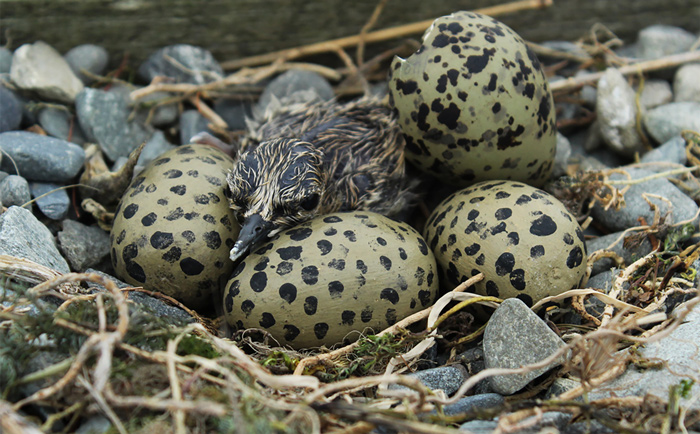
In midwinter they sometimes have to wait for the ice on their feathers to melt before beginning feeding.
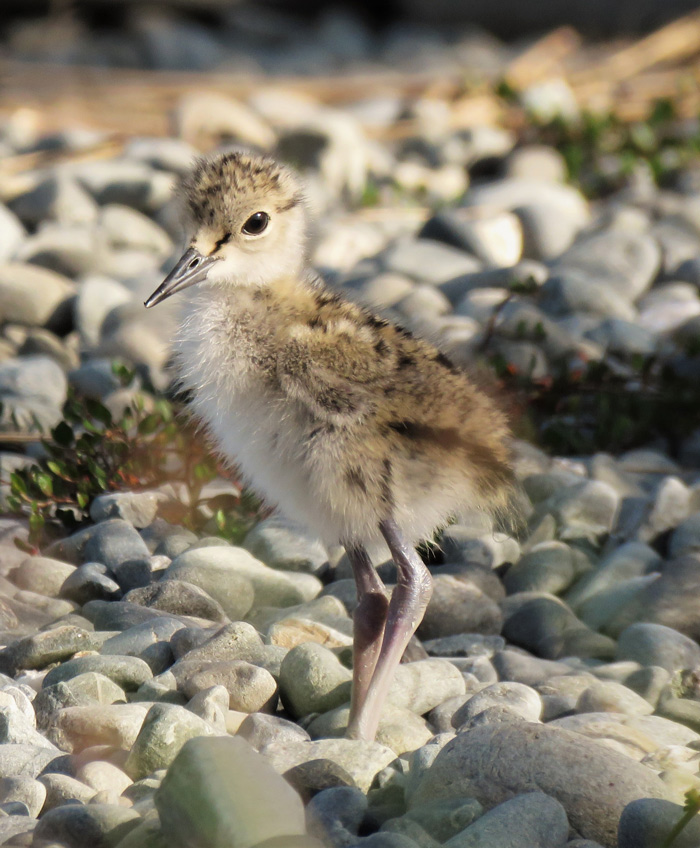
In midwinter they sometimes have to wait for the ice on their feathers to melt before beginning feeding.
THE HUNTED
A little over a century ago, kakī were found throughout the country. They were at least abundant enough to hunt. The earliest mention of the black stilt in the newspaper archive, Papers Past, is from 1868. The article sought to clarify that sportsmen would be able to hunt kakī and other native species, including kererū, without a licence between April and July, but not on Sundays, under amendments to the Protection of Certain Animals Act. The act actually sought to restrict people hunting introduced game, rather than protect native species. It wasn’t illegal to hunt kakī until the 1920s and by then the species was gone from much of the country.
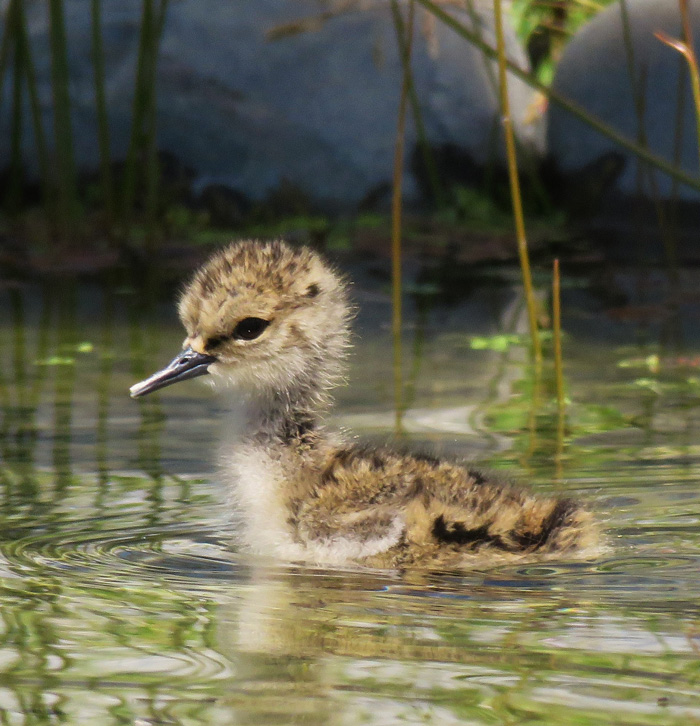
The aviaries are designed to mimic the kakī’s natural environment, with fresh water for bathing.
In midwinter they sometimes have to wait for the ice on their feathers to melt before beginning feeding.
Kakī were once “the common stilt of New Zealand”, according to the national ornithological society, Birds New Zealand, but, like much of the country’s fauna, they were decimated by the introduction of mustelids — weasels, stoats and ferrets — rats and cats, along with habitat loss from draining wetlands for farming. Presumably hunting didn’t help. By 1900 they were no longer breeding in the North Island. By the 1950s they were only found in Otago and Canterbury. Soon after, they were confined to the braided rivers and tarns of the harsh high country of the Mackenzie Basin.
Unlike other wading birds in the Mackenzie — including dotterels, wrybills and terns — the kakī stays in the Mackenzie year-round. In midwinter they sometimes have to wait for the ice on their feathers to melt before beginning feeding. They’re not necessarily built for this environment either, it’s just one of the last places pests took hold. Kakī often nest on riverbeds, which can function as pest highways, and have proved particularly ill-adapted to avoiding mammalian predators.
When kakī made headlines again in 1979 it was because they were almost extinct. The population had plummeted to 50. It was only then that the Wildlife Service started concerted efforts to save the bird. That year, eight eggs were taken from wild nests and incubated at the Mt Bruce national wildlife centre in the Wairarapa and were successfully reared. The following year another eight eggs were taken, reared in captivity and released back into the Mackenzie after a year. “Only one of these birds survived for even a month,” a DOC report recounts. “At least two were killed by harriers before release.”
“It was seat-of-your-pants stuff. We thought it was probably doomed, but it was worth giving it a shot.”
By 1981 there were just 23 birds left in the wild. The release of captively reared kakī was such a failure, however, that the captive release programme was halted. It was five years before the hatchery was built near Twizel and the captive breeding programme that continues began.
Ray Pierce started his PhD on kakī in 1977 and later worked for the Wildlife Service and then DOC studying the bird. He says very little was known about the species when he began his research and there was little funding to protect them. “It was seat-of-your-pants stuff,” Pierce recalls. “We thought it was probably doomed, but it was worth giving it a shot [saving the species]. If there was any large adverse event it could easily have taken out the entire population.” Pierce’s observations showed that introduced predators were to blame for the kakī’s decline. However, at first there was little government funding to tackle this threat. The Wildlife Service conducted annual population counts, but Forest and Bird was the first to stump up funding for predator control to protect them.
“It was seat-of-your-pants stuff,” Pierce recalls. “We thought it was probably doomed, but it was worth giving it a shot [saving the species]. If there was any large adverse event it could easily have taken out the entire population.”
Pierce’s observations showed that introduced predators were to blame for the kakī’s decline. However, at first there was little government funding to tackle this threat. The Wildlife Service conducted annual population counts, but Forest and Bird was the first to stump up funding for predator control to protect them.
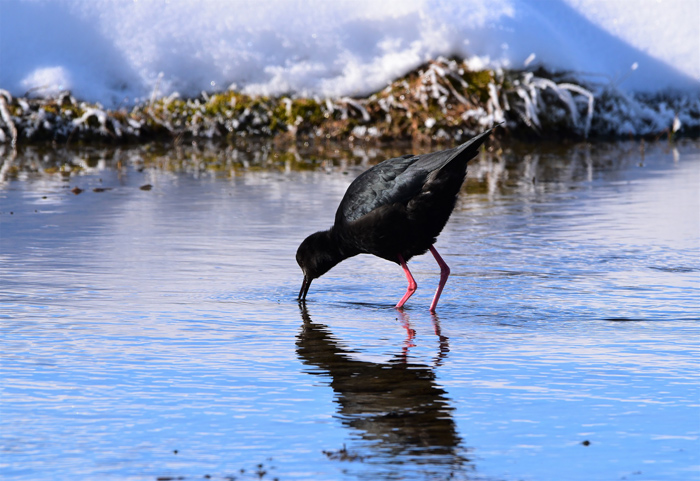
Kakī are the only wading bird that remain in the Mackenzie Basin year-round, often foraging in frozen, snow-lined streams in winter.
THE BIRD FACTORY
When the ice on the eastern flanks of the country’s highest peaks melts, it eventually flows down the Tasman River, a 4km-wide, 20km-long expanse of gravelly moraine. The braided river drains the meltwater from three nearby glaciers — the Tasman, Hooker and Mueller — before flowing into Lake Pukakī.
Looking at it, the word inhospitable comes to mind, but this is home to more kakī than anywhere on Earth. “People look at this and think it’s just a gravelly desert,” DOC ranger Claudia Mischler says, “but there’s a lot of life here once you start looking.”
Mischler is a kakī egg hunter. Each spring, her job — along with a couple of seasonal staff — is to find every nesting pair of kakī left and wait until they start to lay in mid-September. Both male and female kakī incubate the eggs and when they change over, about once an hour, in swoops Mischler.
The birds’ range extends from the Ahuriri Valley near the Lindis Pass, through to Lake Tekapo, a 90km expanse as the kakī flies. Last season there were 33 nesting pairs. Finding them often requires hours of walking up — and in and out of — freezing braided rivers to the foot of the Southern Alps. Once the eggs are retrieved — usually a clutch of four — the pairs can lay again up to five times. It can be January before the final egg is raided. “It’s fullon,” Mischler says. “You do a lot of walking in and out of the rivers all the time. It’s not for everyone.”
Fortunately, the largest population of kakī is also one of the most accessible. About 45 live in the Tasman River valley year-round, many just off the busy road to Mt Cook, where about a million tourists would drive each year before the pandemic. Though few would stop to look, this makes kakī one of the most accessible of the country’s 18 critically endangered birds, the last classification before extinction.
After fording a couple of freezing, thigh-deep branches of the Tasman, we soon encounter our first kakī, beak down, scything the water for critters, about 100 metres from the road on the river’s true left. Mischler then begins looking for Hamish and Julia, a pair that nest on nearby Braemar Station and have been named after the station’s owners, Hamish and Julia Mackenzie. Mischler has known most of the birds on the delta since before they were born. It’s likely she took their eggs from here during a recent spring. It also makes her keenly aware when the birds disappear from the delta: missing presumed dead. “It’s sad, but it’s life.”
The eggs Mischler retrieves are taken to the captive management facility near Twizel where they are incubated, hatched and hand-reared for a month by a team of three full-time staff and a seasonal recruit. Then they go to the on-site aviaries until they are released into the wild in August. The birds can be fiercely territorial and if they stay in captivity any longer they can begin to kill each other.
“A lot of people are critical of us doing what they believe is stealing eggs from birds,” Liz Brown says. “But it’s no different really from a stoat or a rat coming and eating their egg, or a flooding event in the wild. As far as we are aware, they don’t grieve over lost eggs. They go away and they lay more. We are mimicking a natural thing.”
“As soon as we get them outside they’re out in the gravel and sunshine and they’ve got water to bathe in.”
The clinical setting is also necessary, Brown says. “Any animal that’s in a confined space with a lot of others there is a high chance of a disease outbreak. That’s why we are using brooders that look nothing like the wild environment. But as soon as we get them outside they’re out in the gravel and sunshine and they’ve got water to bathe in, so we do try to make it as natural as possible on the outside, while still maintaining a facility that we can fully disinfect and manage for disease.”
The facility can cater for up to 120 kakī juveniles, while others can be raised at a captive breeding facility run by the Isaac Conservation and Wildlife Trust in Christchurch.
Each kakī pair can lay up to 20 eggs in a season and Mischler’s team can retrieve more than 200 eggs a year — the record was in 2018, when they netted 264. Because so many eggs can be retrieved, Brown explains that only those in perfect condition are reared.
“If we have chicks that aren’t of the quality to become good wild birds, we might make the difficult decision to euthanise them, particularly if we think it might have inherited conditions,” she says. “We don’t want to be compromising the genetic health of the wild population.”
The high egg output is one of the big factors working in the kakī’s favour. Kākāpō only breed every two to four years, in seasons when rimu produce enough fruit, and only produce one to four eggs a season. About 60 per cent of their eggs are also infertile or die at the embryo stage. Kiwi typically only lay one egg a year. In other endangered species, it’s also impossible to remove the eggs just after they’re laid — they need to be incubated by the parents in the wild first, putting them at risk.
It’s taken a long time for the programme to become so successful, however. After an initial recovery, the kakī population remained static. There were 52 birds in the wild in 1991; 48 in 2000. A kakī recovery plan the following year set a target of increasing the population to 125 breeding pairs by 2011. But in 2011, the total population was still only 57.
For a time, the programme itself was threatened by a lack of funding. In 2015, a large snow storm destroyed one aviary and damaged another, reducing how many birds could be reared. DOC wouldn’t stump up the $500,000 required to replace them. Eventually, in 2017 the US-based not-for-profit Re:wild agreed to fund the new aviaries, which opened the following year. It also funded a new brooder room for hand-rearing chicks, with DOC chipping in.
Despite the setbacks, the kakī population boomed. In the 2010s, the wild population almost tripled, reaching a high of 170 in 2020. The number of captively raised birds being released also accelerated. Since 2017, more than 100 birds have been released each year.
“The project is at the stage where we’re good at finding the birds, we’re good at rearing the birds, we’re good at getting them out into the wild, it’s just getting them to survive once they’re out there now.”
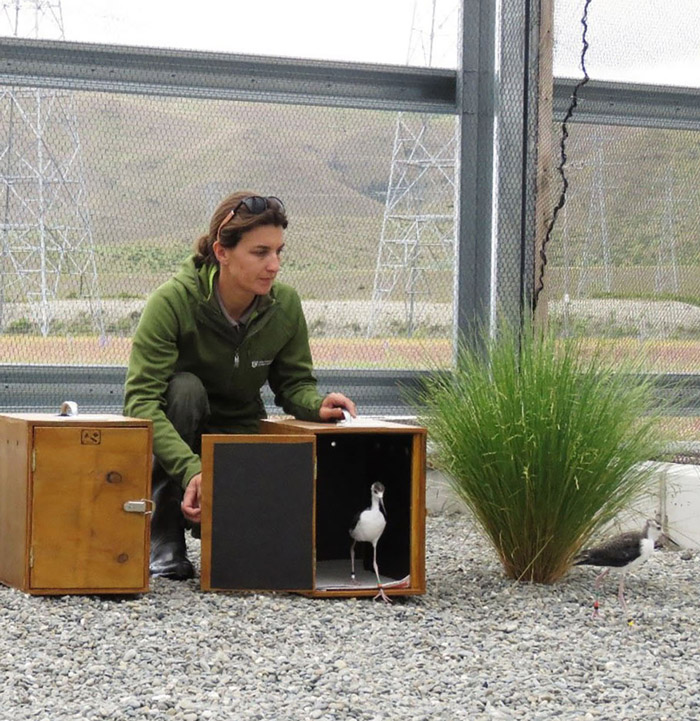
In 2018, DOC staff released the first kakī chicks into new aviaries near Twizel, which were built after two aviaries were wrecked by a snow storm in 2015.
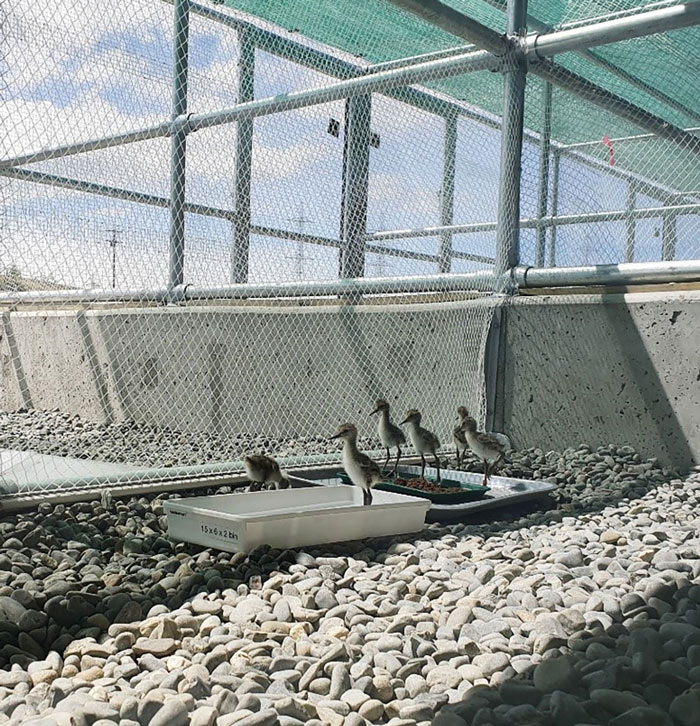
For their first month, chicks are given restricted access to outdoor cages while they’re being hand-reared. They remain in broods of six for their first year.
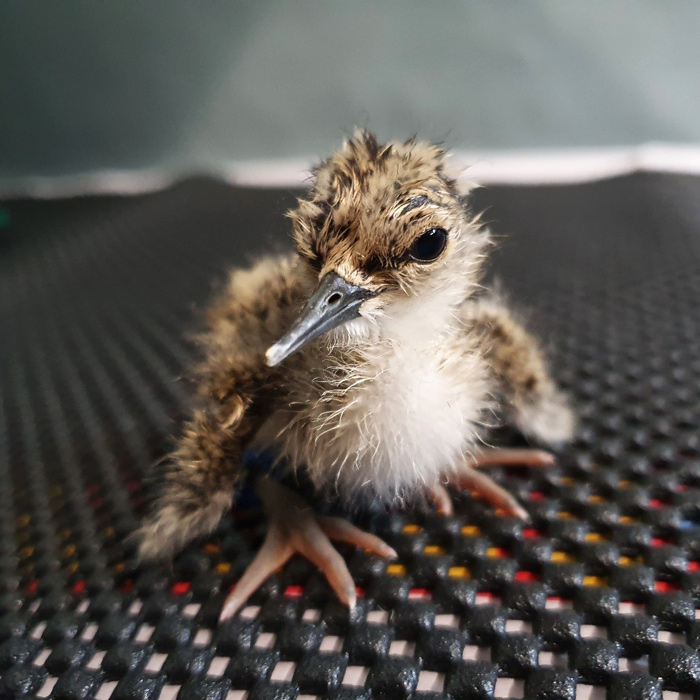
A recently hatched kaki chick in the new brooder room near Twizel.
While releasing 100 birds a year sounds positive, Brown and her team need to release at least that many to prevent the population from going backwards. The adult population — those aged two years or older — has plateaued in the last couple of years. It is now down to 143.
The problem is only about a third of the birds released survive their first year and about 25 per cent of the adult population die each year. Their life expectancy is subsequently low. While the oldest kakī in the population is 22, on average they only live 5.8 years. The birds are also reluctant to breed. There are only 33 breeding pairs.
It’s not entirely clear why. Predators are known to be a major factor driving the mortality rate, but areas with intensive predator control haven’t shown significant improvements. The Tasman River delta for example has had intensive predator control since 2004 and the recruitment rate has fluctuated but shown no clear improvement. Just 28 per cent of the birds released there make it to breeding age. The mortality rate and life expectancy has similarly been highly variable year-to-year with no discernible improvement.
It may be that the birds are succumbing to predators when they leave the protection of predator control, but at the moment it’s just a best-guess. Most birds that die in the wild are never recovered. They just disappear. If any remains are found, they’ve often been scavenged by something else, making it impossible to determine the cause of death.
“Those that die after being released, were they eaten or did they just not find enough food and starve? We don’t know because we don’t find those bodies,” Mischler says.
Researching the causes of kakī mortality in the wild has been on the to-do list for decades — it was a priority in the 1991 kakī recovery plan — but so far little work has been done. Research has been limited by funding, but also technology. The birds only weigh 220 grams and have a large range, making tracking using radio transmitters difficult. But new, smaller GPS transmitters may make tracking possible and affordable in future so that dead birds can be recovered for research before they’re scavenged.
The predators aren’t just introduced, either. A New Zealand falcon — itself an endangered species — hangs around near the kakī release site on the Tasman River, preying on juveniles. “There’s not much we can do about that,” Brown says. “That’s the reality of their world.”
The very method that is saving the species may also be limiting their recovery. Some kakī starve and it may be that captively reared birds are missing out on learning feeding techniques and other survival behaviour that they would normally learn from their parents in the wild.
“They’re very naive when they leave here,” Brown says. “We supplementary feed them for six weeks after they’re released and slowly wean them off to try and give them a decent amount of time to learn how to be a wild bird whilst getting the food that they’re used to.
“Fortunately, foraging for food in the water is an innate behaviour, but figuring out how to get enough of that in the wild so they’re not going to die, while also figuring out that water moves fast, how to fly, land and avoid predators is tough.”
The captive rearing programme tries to be as handsoff as possible to try to retain their wild nature. Every time the chicks are handled a kakī alarm call is played so people are perceived as a threat. But the birds are still naturally curious and ill-adapted to predators. When a warning call is played, a chick’s natural response is to drop to the ground and stay still.
“It’s really useful if your predator is avian, like a harrier or falcon, because they can’t see you,” Brown says. “But it’s not so useful if your predator is a cat that can smell you.”
Mischler is planning on leaving some eggs in the wild this season to monitor how this impacts the birds’ survival, but with so few left it’s a risk.
Then there’s the kakī’s habitat. Floods appear to be becoming more severe with climate change and can flush rivers of invertebrates for a week or more. “We don’t know much about changes in their food supply because no one’s looked at it,” Mischler says. “It’s on the list, to understand how it influences the breeding season.”
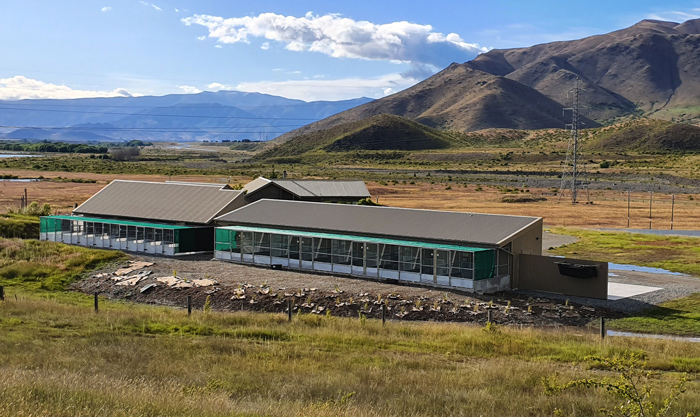
The large new brooding facility was built in 2019 near Twizel with funding from US-based not-for-profit, Re:wild.
LIFE ON THE FARM
About half
of kakī nest on private farmland, so their survival relies on cooperation with Mackenzie Country farmers. Mischler says historically there has been a lack of trust between DOC and local farmers and at first they were hesitant to let staff on their land to monitor nests. But slowly she’s built up trust with landowners and most — but not all — let her on their land to retrieve eggs and tell her if a pair is nesting.
Hamish and Julia Mackenzie have owned Braemar Station for 23 years, taking over from Hamish’s father, Duncan, who bought the station in 1969. The 15,000-hectare station borders Lake Pukakī, near the Tasman River delta. But the farm has also become a favourite of the pair of kakī dubbed Hamish and Julia, which come back to Braemar each year.
“Once you see results, like releasing 60 kakī when there’s only just over a hundred in the wild, it’s quite special,” Julia says. “In spring we can have 13 or 14 birds flying around and there might be six in one little pond. A lot of people have never seen them and when you tell them, ‘That’s the world’s rarest wading bird right there,’ they’re like, ‘Really!’”
Despite the highly modified environment, the kakī don’t seem bothered by the farm operation, showing little fear of stock, people or even vehicles. Mischler takes me on a farm tour, showing me the haunts of different nesting pairs. It’s not what you might expect. Kakī seem to be attracted to shallow, muddy ponds, often little bigger than a puddle. “There are more bugs here and they’re probably easier to pick off,” Mischler explains. “And it’s not just kakī, there’s dotterels and everything under the sun in those paddocks.”
There’s even a pair that migrates to a dairy farm in Waimate to breed, about 100 kilometres away. The farmer fences off their nest each year and is eager for them to keep returning. “They love it,” Mischler says. “They’ve been there a few years now. It’s not a good spot, it’s just a random pond. I’ve got no idea why they ended up there, but the landowners are really good. They take their cows off the land just for the birds and they go out of their way to make it work. They’re really excited to have this pair there, so for their interest I hope they keep returning because they just love having them.”
While the cooperation of Mackenzie farmers is welcome, it also highlights the immense challenge of saving the species from extinction. Kakī can’t be contained on a predator-free island. Their habitat includes dozens of landowners, often with little predator control, and removing predators from their entire range seems almost impossible. But a new project aims to do just that, creating the largest pest-free zone in the country.
A KAKĪ FORTRESS
The glaciated peaks
that hem kakī into the Mackenzie Basin may be the thing that ultimately saves them. The Southern Alps create an impenetrable wall stretching across the western edge of the kakī’s range. Most are also in a zone bordered by two other natural barriers — Lake Tekapo to the north and Lake Pukakī to the south. Linking these two lakes is the 25km turquoise Tekapo Canal, about 30 metres wide and up to 10 metres deep. A new project aims to use these features as a natural predator-proof fence to create a pest-free zone unlike anything attempted before in New Zealand.
The Te Manahuna Aoraki project started in 2018 with a goal of eliminating mammalian pests from 310,000 hectares of the Mackenzie Country by 2040, roughly between Lake Tekapo and Pukakī and west to the Main Divide. It’s an enormous area, almost twice the size of Rakiura Stewart Island and almost four times the size of Tongariro National Park, and covers about 80 per cent of the kakī’s range. So far, 4690 traps have been laid over 60,000 hectares and almost 15,000 predator pests have been removed.
The project is run by a charitable trust founded by DOC, iwi and the NEXT Foundation, which manages a $100 million fund for environment and education projects started by philanthropists Annette and Neal Plowman. The government has also committed more than $16 million to the project but in total it is expected to cost $80-$90 million.
Unlike previous predator control projects, Te Manahuna Aoraki also relies on working on private land. About 40 per cent of the area is high-country farms — either privately owned or leased Crown land — including 14 landowners. The remainder is mostly conservation land managed by DOC, including Aoraki/Mt Cook National Park.
It’s a method that has been honed and tested by Zero Invasive Predators (ZIP), a research and development entity founded by DOC and the NEXT Foundation, which is delivering the project. ZIP has recently eliminated predators from a 12,000-hectare block in South Westland, using the alps and rivers as natural barriers, and plans to expand this to a 100,000-hectare predator free zone by 2026.
Te Manahuna Aoraki project manager Simone Smits says these methods have shown that eradicating pests and then keeping them out can be more cost-effective than ongoing suppression trapping.
“Suppression trapping is really expensive and you’re only skimming off some of the predators, not removing them, so that cost is forever,” Smits says. “But once we’ve removed them, the maintenance costs become surveillance around the borders of the zone, which is far lower.”
Ongoing costs of maintaining the predator-free zone will be shared between the trust, landowners and DOC.
“Our job is to do ourselves out of a job.”
Smits started her career in conservation working with kakī at age 17, volunteering at the centre near Twizel before landing a job there full-time. She began managing Te Manahuna Aoraki when it started in 2018. Smits is confident the project will enable kakī to thrive in the wild once more. She says the early results show the nesting success rates for other river bird species has increased from 30 per cent to 90 per cent with predator control. “We’re seeing really positive trends for banded dotterel and black-fronted terns, but to change the game for these species we need to entirely remove the threat.
“DOC has been exceptionally good at raising birds, but the second phase is removing the threats in the wild and improving the habitat. And if we can do that then kakī really have an opportunity to thrive.”
It’s early days and the efforts so far haven’t reduced the mortality rate for kakī yet. But Brown and Mischler are cautiously optimistic. “I think it could do wonders for these guys [kakī], and everything else that’s here,” Brown says. “My gut says if we got on top of the predator issue we’d see significant population increases.”
But increasing the wild population to the extent that the captive management programme could wrap up is “a very, very long way away”, she says. “Our job is to do ourselves out of a job, but we’d want thousands in the wild to comfortably walk away without the risk of them going extinct. We’re struggling towards 200 at the moment, but we’ll get there.”
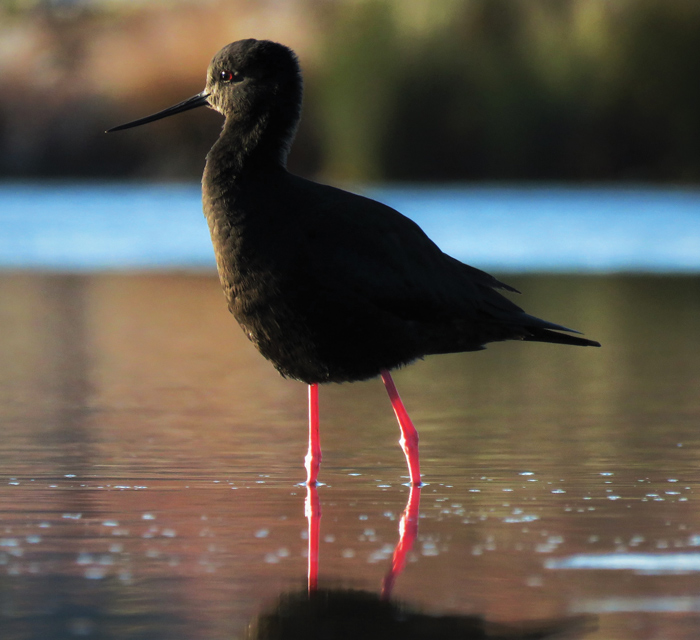
An adult kaki wading through the shallows of Lake Ruataniwha, near Twizel.

Juvenile kakī can be distinguished by their smudgy grey-white plumage, which they lose after their second summer.
George Driver is North & South’s South Island correspondent. This role is made possible by support from NZ On Air’s Public Interest Journalism.


